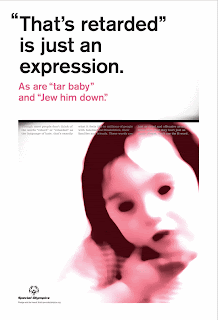


In the last post, Goehner talked about the 6 questions you should ask when evaluating a social awareness poster. I chose to post this campaign by the Special Olympics to challenge people not to use "retard" as slang because I think these posters are an excellent example of all 6 points.
1. Attract the attention of a viewer.
This poster definitely grabs your attention. Sure it's mostly by shocking you, but shock is a proven method in social awareness campaigns. The key is to shock with a purpose.
2. Hold the viewer’s attention long enough to read the content.
Because the text is so shocking it makes you curious to know their point and you keep reading. Notice though that there still isn't very much small text, just enough to explain and drive the point home. No one is going to stand there and read a huge block of tiny print, no matter how fabulous your hook is.
3. Evoke an emotional response.
The comparisons these posters make between retard and other offensive words you would never say makes you think of all of the times you've used retard that way. It's personal and convicting.
4. Encourage action.
The emotional response makes the challenge is immediate and clear: stop saying retard.
5. Give the viewer adequate information to act.
Since the action they are trying to evoke is immediate they don't have to provide extra information. By making you feel the offensiveness of the word they provided you with the information you needed. You don't have to go to a website or make any extra step at all which is why you're more likely to act.
6. Give the viewer something to take-away to contemplate.
I found this campaign a year ago when I was researching for my Graphic design 2 social awareness poster and I'm still contemplating it a year later... Impressive. Again, it's all in the emotional response.
The effectiveness of this campaign really is all tied to the emotional response it creates. It's what makes the poster memorable, it's what makes someone want to act, it's really what makes our poster worth anything. Clever style will never make up for lack of content in a social awareness poster. The style of these posters isn't particularly clever or original or emotional, but that's beside the point. What matters is that I remember these posters a year later and haven't said retard since.








